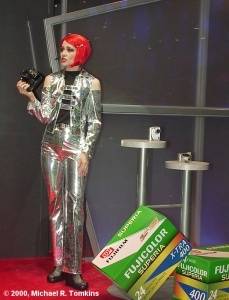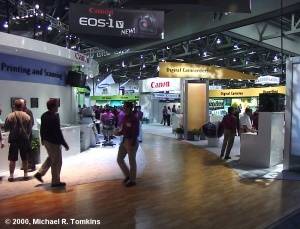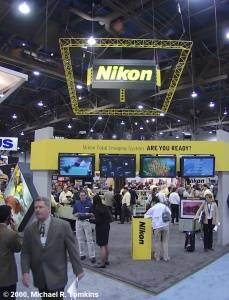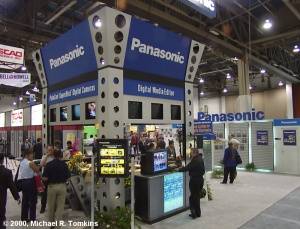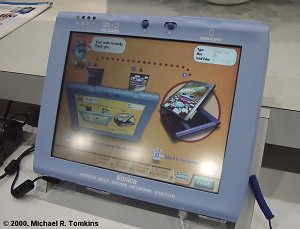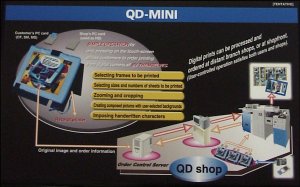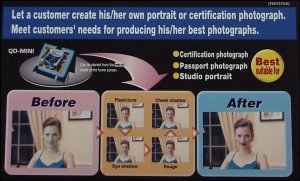| The PMA 2000 report | |
Photo Marketing Association Show 2000
After-Show Wrapup
Monday, February 14, 2000
Info on Canon S10 updates, and lots more PMA news! - (3:02 EST)
We received an email from IR reader David Kamanski with news that he's posted a web page with loads of info from the PMA show, as well as news of an upcoming firmware upgrade for Canon PowerShot S10 users... There's also sample pictures from the PowerShot S20 and Fuji FinePix 4700, as well as more pictures of Canon's Digital EOS - and David still has more to come! Check it out!
Source: The Digital Picture
Thanks to David Kamanski for this item!
LOTS of photos of the PMA Show! - (1:58 EST)
One of many people we met at the PMA 2000 show was Jack Olmsted of the DVDReporter website - we met him in the press room, where he was spending a lot of his time, uploading some of the hundreds of photos he took at the show. We received an email from Jack over the weekend, to let us know he's uploaded all these images now - and there's some really cool ones, like the view above shot from the catwalk above Kodak's booth. You can find links to all this from the DVD Reporter site, or alternatively can find the photos on the EMemories, Zing, and GatherRound websites, under the username "DVDReporter"...
Source: EMemories Intro page for Jack Olmsted's PMA Photos
Thanks to Jack Olmsted / DVD Reporter for this item!
Thursday, February 10, 2000
Fuji recaps PMA awards! - (18:38 EST)
"FUJIFILM'S FINEPIX S1 PRO DIGITAL CAMERA TAKES TWO TOP HONORS AT THE DIGITAL IMAGING MARKETING ASSOCIATION'S ANNUAL SHOOT-OUT
Fujifilm's MX-1700 ZOOM Digital Camera and Pictrography 3000 Digital Printer Also Garner Awards
LAS VEGAS, NV, February 5, 2000 - The enhanced quality of Fujifilm's digital imaging products took center stage at the Photo Marketing Association (PMA) trade show here as the company's new FinePix S1 Pro digital camera won two awards at the Fourth Annual Digital Imaging Marketing Association (DIMA) Digital Camera Shoot-Out. Prints from FinePix S1 Pro were chosen as best in the $5,000 and Below Professional Photographic Category, and the camera also was a winner of DIMA's prestigious Innovative Digital Product Award.
In addition to the accolades for the FinePix S1 Pro, Fujifilm's MX-1700 ZOOM won the Point-And-Shoot, $300-$599 Category. In the separate DIMA Digital Printer Shoot-Out, the Fujifilm Pictrography 3000 took top honors in the Small Format (8 �" x 11" or less) Category.
Pictures captured by the FinePix S1 Pro and MX-1700 ZOOM were chosen "Best" in their respective categories by PMA convention-goers based on print quality, production and price. Manufacturers entered in the DIMA Shoot-Out were asked to bring their digital cameras to a specially constructed studio and shoot a series of models and scenes. Pictures captured by cameras in the Point-and-Shoot and Professional Photographic categories were sent through similar computers running the same image editing software and outputted from the same printer. The prints were then taken to the trade show floor where they were displayed, anonymously, and voted on by PMA tradeshow attendees. The first SLR digital camera with Fujifilm's new Super CCD image sensor, the FinePix S1 Pro has a 1.1-inch sensor that delivers an ultra-high resolution image file with 6.1 million pixels (3040 x 2016 resolution). It has a Nikon F lens mount for use with existing optics and has continuous shooting of approximately 1.5 frames/second up to five frames, adjustable ISO equivalents of 320/400/800/1600, a shutter speed of 30 to 1/2000 second and compatibility with SmartMedia (up to 64MB), CompactFlash (Card Type II) and the IBM microdrive. The FinePix S1 Pro will carry a manufacturers suggested list price of less than $4,000 when it ships in June.
About Fujifilm Digital Imaging
As the first manufacturer to offer a digital camera with removable storage media and the developer of the new Super CCD sensor, Fujifilm is a recognized digital imaging innovator. With a breadth of line that includes products for image capture, storage and output, Fujifilm offers a host of end-to-end imaging solutions, letting the user evolve from picture-taker to picture maker within minutes.
What sets Fujifilm digital imaging products apart is the technology that goes into each and every product. Fujifilm is one of only a handful of marketers that both designs and manufactures the key capture elements of a digital camera -- the lens, CCD and image processing mechanisms. This total control ensures strict adherence to design specifications.
Fuji Photo Film U.S.A., Inc. is the U.S. marketing subsidiary of Fuji Photo Film Co., Ltd., of Tokyo, a leading manufacturer of imaging and information products."
Toshiba PDR-M5 wins award at PMA! - (13:52 EST)
"Toshiba PDR-M5 Wins Prestigious DIMA 'Digital Camera Shoot-Out' At Photo Marketing Association Show, Named Best Camera in $600-899 Category
IRVINE, Calif.--(BUSINESS WIRE)--Feb. 10, 2000--Toshiba Imaging Systems, a division of Toshiba America Information Systems, Inc., announced today that its PDR-M5(TM) two-megapixel digital camera garnered top honors at the 2000 DIMA Digital Camera Shoot-Out at the Photo Marketing Association (PMA) Show in Las Vegas, Nevada, beating out cameras manufactured by Kodak (DC290), Olympus (C2020 Zoom), Epson (Photo PC850Z) and Casio (QV-3000) in the highly-coveted $600-899 category.
Sponsored by the Digital Imaging Marketing Association (DIMA), the Shoot-Out honors the best in digital imaging technologies, and is one of a number of major awards that Toshiba has received for its digital camera line. The Toshiba PDR-M4(TM) megapixel camera also scored highly in the contest, winning third place in the competitive $300-599 category.
The independent members of DIMA, who judged entries on the basis of image quality and price, cast votes. Forty digital camera entries and 18 manufacturers participated in the Fourth annual event, which took place on Wednesday, February 2.
``Toshiba is very honored to be singled out among the dozens of digital camera makers as having the best camera the consumer can buy in this popular category,'' said Doug Freck, Vice President & General Manager, Toshiba Imaging Systems.
``Today's victory validates our position both as a technology leader and as a manufacturer the consumer can turn to with utmost confidence as having the product with the features and capabilities that they value most highly,'' Freck said.
Introduced in June 1999, the groundbreaking PDR-M5 ($799 US) offers an advanced 1/2-inch, 2.14 million CCD (1600 x 1200); built-in five-mode flash; AVI movie function; an all-glass aspheric lens with 3X optical zoom; macro mode for enhanced close-ups; plus extremely fast recycle, burst and USB downloading rates.
For information, U.S. customers call 1-800-288-1354. Fax, 1-800-640-8674. Or visit Toshiba on the Web at http://www.dsc.toshiba.com.
Headquartered in Irvine, California, Toshiba Imaging Systems is a division of Toshiba America Information Systems, Inc., and part of the $48 billion Toshiba Corporation, a global leader in high technology products with 307 major consolidated subsidiaries worldwide."
Source: Yahoo! BizWire
Wednesday, February 9, 2000
More on the Olympus C-2500L firmware upgrade - (18:04 EST)
Our apologies for the delay getting back to this piece of news, which we first mentioned in our PMA Day Two coverage (several readers have prompted us several times, and we just kept getting sidetracked!) The new firmware for the Olympus C-2500L which we told you about contains the following changes:
The C-2500 firmware upgrade sounds fairly minor, from what we've heard. Here's the info we have available:
1) There's now a "medium" option for sharpening, between the previous "soft" and "normal" settings.
2) There's a new slow-sync flash mode.
3) AE lock (half-press of shutter button) now works in both Spot and Averaging metering modes. (Previously wouldn't lock in spot mode, only in averaging.)
We think that existing units can be upgraded to the new firmware, but have to admit we're not completely sure on this point. We were also told that the C-2500L is now compatible with Olympus' new lithium manganese batteries - this change is likely only for new C-2500s as it would require a slightly different shape for the battery compartment to accommodate the new batteries, we believe...
PMA's over, time for a recap! - (2:35 EST)
With the Photo Marketing Show 2000 now behind us, it's time for a recap of the show - and all the new products we saw... This year's show was impressive not only for its size (PMA is not as big as Comdex, but it is still easy to spend half your time just trying to find the booth you're heading for!), but also for the number of digital products on display... With companies like Pentax, JVC and Samsung looking to join the regulars such as Nikon, Olympus, Kodak and Sony, there has to have been a record number of digital cameras at the show this year - and most of these models showed great promise.
As usual, the big names had big shows on to attract the crowds - and these are interesting of themselves, as they give you a feel for which products a company is pushing the most, and also as to just how many marketing dollars are there to back those products.
Click for a bigger picture!
Canon's gave us "Canon Presents... Broadway", with a 6-person Broadway troupe performing at regular intervals throughout the day in front of a video wall. We didn't get a chance to see the whole of this performance once through, but what we did see was great fun - and a little less "commercial" seeming than some of the other performances... We didn't get to see whether the show was being used simply to draw a crowd, or whether the performers were also reeling off statistics on the latest products in the intervals, but they did have a carefully positioned ad for the PowerShot S20 right next to the stage.
Click for a bigger picture!
Fuji went for a more straightforward approach - three models in extremely colorful wigs and sparkling metallic costumes went through a well rehearsed performance, describing Fuji's latest products and showing them off at the same time, whilst three huge video walls in the background played a well choreographed mixture of music and footage of the new products. Both the SuperCCD cameras, the Fuji Finepix 4700 Zoom and FinePix S1 Pro were highlighted, along with Fuji's home photo printer and store-based digital print ordering systems.
Click for a bigger picture!
We'd have to vote Olympus' show as probably the second most popular, based on how difficult it was to get past their booth whenever a performance was on. An extremely energetic performance from four people singing and dancing, accompanied by live saxophone and drums made for a fast-paced show with plenty to keep the attention of the audience. Yet another video wall in the background assisted the performers in showing off Olympus' products, including the C-3030 Zoom digital camera.
Click for a bigger picture!
Perhaps the most popular show of all was that from Samsung. A selection of pop music was played in the background, whilst three singers took turns on the stage, dancing and singing lyrics altered to advertise Samsung's CyberMax and Digimax digital cameras, as well as their film cameras and more. Two extremely energetic (not to mention flexible!) dancers accompanied this throughout, and for a finale, all five performers filled the stage in front of (yes, yet another) video wall. This was rounded off with a give-away of a Samsung film camera after each performance.
The shows themselves were certainly impressive to watch, but were unquestionably surpassed by some of the products on display this year... Here's a run-down on what we saw at the Digital Focus and PMA events, from each manufacturer:
- Agfa
Click for a bigger picture!
Agfa showed its existing line of digital cameras and scanners.
- Canon
Click for a bigger picture!
Without doubt, the big news for digital imaging on Canon's stand (and possibly the big news of the show, if the response on our news forum pages was anything to go by!) was Canon's new EOS digital SLR. Little information accompanied the camera, which was shown behind glass in the center of Canon's booth - but the unit apparently will surface in Fall of this year, with a 3 megapixel CCD and interchangeable Canon EF mount lenses. Canon's PowerShot S20 also showed, as did a new EOS film camera, the 1V.
- Epson
Click for a bigger picture!
Epson showed three new printers at PMA, all variations on a theme. The new printers accept roll paper (allowing for printing photos continuously, and then cutting them apart, saving on paper waste), as well as edge-to-edge printing (thanks to special receptacles to catch the ink which went off the edge of the paper), and most impressively, new light-fast inks and papers which should give close to the fade properties of silver halide prints. The printers were a wide format version, a standard version, and a standard version with a built-in PC card reader. Epson also showed its existing scanner and digital camera lines...
Dave's tech note: The light-fast inks and media the new Epson printers take are really big news. Fading has been the big bugaboo preventing inkjets from making serious inroads against conventional silver-based photo prints (IMHO). Epson projected lifetimes of 10 years for their glossy media and 26 years for their matte-finish product. What's most impressive about these numbers is that they come not from Epson themselves, but from Wilhelm Research, the absolute horse's mouth on all aspects of print permanence. Now, no need to worry about whether digital prints you make for friends and relatives will go the distance!
- Fujifilm
Click for a bigger picture!
Fuji gave SuperCCD a lot of space on its stand, showing the new CCD layout that it has designed in two digital cameras, the Finepix 4700 Zoom and Finepix S1 Pro. We played with a working 4700 Zoom at the Digital Focus show, and found it to be very well designed ergonomically, and quite responsive. The S1 Pro was similarly impressive, and very difficult to get near on the Fuji booth, with crowds of people wanting to see it. Fuji quite obviously put a lot of effort into PMA, with lots of prime advertising space (the back cover of all the show guides, as an example) and the Fuji blimp (which we enjoyed a ride in last November at Comdex) in town... Also shown was Fuji's photo lab equipment, digital print ordering systems, and a whole lot else besides... This was one of the largest booths of all, with probably only Kodak and Canon managing larger. We tried the S1 Pro out for ourselves, curious to see how it fared - there has been a lot of controversy on the Internet regarding Fuji's decision not to quote the actual pixel resolution, instead quoting an interpolated figure which Fuji feels to be the camera's equivalent when compared to conventional CCD based cameras. We felt the camera fared well against three megapixel cameras, showing perhaps slightly more definition and significantly better noise, but against a true six megapixel camera the difference in resolution was quite noticeable. The results are highlighted in our comparison of the S1 with Nikon's D1, and Kodak's DCS330, 620 and 660. It will be very interesting to see a final version of the S1 go under the microscope in more controlled circumstances - we felt that overall the camera fared pretty well in this not-quite-scientific testing!
- Hewlett Packard
Click for a bigger picture!
HP showed two new digital cameras, one of which features a 2/3" frame transfer CCD and an SLR design. Both cameras feature the Digita operating system and Pentax lenses, and are also to be sold under the Pentax name... The HP C618 / Pentax EI-200 features a 2.1 megapixel CCD, 3x optical zoom, aperture and shutter priority modes, and infrared printing, whilst the HP C912 / Pentax EI-2000 features the 2/3" 2.24 megapixel frame transfer CCD, 3x optical zoom Pentax lens, infrared printing, SLR design, and manual focus, exposure, color and flash control. Both cameras were shown behind glass by HP and Pentax, and booth staff would not reveal details beyond that in their press releases.
Dave's tech note: Frame transfer technology in a consumer digicam is big news. Frame transfer (as opposed to the more common interline transfer) gives higher light sensitivity, less image noise, and potentially better color fidelity. Previously, frame transfer CCDs were only found in high-end Kodak professional models, never in cameras costing less than several thousand dollars. It'll be interesting to see how the HP camera with this sensor performs!
- JVC
Click for a bigger picture!
JVC has chosen 2000 to re-enter the digital camera marketplace, with its impressive looking QC-GX3 on show at PMA 2000. The -GX3 features a 3.3 megapixel CCD and 2.3x zoom lens in a fairly small camera. As well as its unusual control positioning (it features a mode dial on its side, next to the zoom lever and a mode lever, all within reach of your thumb - a control system that was surprisingly easy to use, at least in a show setting), the camera also features 3 special "Pro Still" modes, each of which promises enhanced pictures for still images. The first shifts the light up by one pixel on the CCD between the first and second shots, to allow for less interpolation of the image data; the second mode allows multiple still images to be averaged to reduce noise; the third allows a dark and light picture to be combined into one with increased dynamic range. Clever tricks that could be very useful, although only when the camera is on a tripod and there's no movement in the subject...
Dave's tech note: Another potentially really big deal, blurring the line between professional studio cameras and consumer point & shoots. If the Pro Still Mode" tricks in the GX3 work at all as advertised, we could see a lot of them making their way into commercial studios. Anyone looking for an inexpensive solution for high-end product photography may benefit from
this technology!
- Kodak
Click for a bigger picture!
Kodak showed its full range of Pro digital cameras, several of which we were able to try out briefly as part of our image comparison - the DCS330, 620 and 660. Also on show were Kodak's existing line-up of digital cameras, in what was probably the most impressive looking booth of the show (it looked like something out of Star Trek, painted in Kodak colors and with a large globe mounted on the top - it really defies description!)
- Leica
Click for a bigger picture!
Leica showed its new Digilux Zoom, which it announced was due to ship later this year - but which a reader reliably informs us has been shipping since the end of last year... The Digilux Zoom is a rebadged MX-1700. Also on display was a slide-scanning attachment for the Digilux Zoom, which literally mounts on the front of the camera, to hold a slide at just the right distance to be photographed...
- Minolta
Click for a bigger picture!
Minolta showed its new Dimage 2300 digital camera, a nice little unit which featured a 2.3 megapixel resolution, and attracted quite a lot of interest when we were playing with it at the Digital Focus event (we had to queue for almost ten minutes to get our hands on one!) Also on show was the Dimage Scan line, with the Dimage Scan Elite, Scan Speed and Scan Dual at the show. The Dimage Scan Multi received a free version of Canto Cumulus single user, as well as a new Universal Holder, making the bundle more attractive...
Dave's tech note: Cumulus is a nice software addition to the Dimage Multi. Several years back, I did a consulting job for a large imaging company, evaluating image-organizer tools, and Cumulus was one of the nicest I saw. Other big news, if not entirely new, is that the Dimage Scan Elite uses the "Digital ICE" defect-removal technology from Applied Science Fiction. Heretofore, the Nikon LS-2000 and LS-30 were the only film scanners on the market with this technology, which can have a *huge* impact on productivity, even when scanning relatively clean slides with little dust and few scratches. Check our reviews of the LS-2000 and LS-30 for more info on this almost-magical technology!
Very good news indeed that another scanner manufacturer has picked it up!
- Nikon
Click for a bigger picture!
Nikon showed its D1 Pro camera, as well as the newly announced Coolpix990. The 990, announced just before PMA, looks to be a very nice camera, with intuitive controls, great speed, and the same swivel design that its older siblings featured. We have a prototype 990 in-house right now. We should have some preliminary photos online in the Comparometer(tm) by the time this issue goes to press, and a full review up shortly after Dave returns from vacation on 2/20. Initial results are *very* impressive, even though the prototype unit we have shows more image noise than we're told to expect in the production models.
- Panasonic
Click for a bigger picture!
Panasonic showed its PV-SD4090 PalmCam, which uses 120MB SuperDisk media to save images from a 1.3 megapixel CCD and 3x optical zoom lens.
- Pentax
Click for a bigger picture!
Pentax has chosen to ally with Hewlett-Packard for its re-entry into the digital camera market, with both manufacturers to release their own versions of two new cameras. See the HP section for more details.
- Polaroid
Click for a bigger picture!
Polaroid showed its existing line-up of digital cameras, as well as Polaroid products and its i-Zone sticker cameras.
Dave's note: Polaroid has been focusing heavily on the mass-consumer market, with inexpensive cameras distributed through the likes of K-Mart and Wal-Mart. We haven't seen any of these for review, but were surprised to learn in a press release yesterday that Polaroid claims to have shipped 400,000 digital cameras in 1999!
- Silicon Film
Click for a bigger picture!
Silicon Film showed its eFilm EFS-1 digital film cartridge for film cameras at the show. The EFS-1 is now planned for a mid-year release at a price of $699 for a 1.3 megapixel version. USB capability has been added to the ePort (which reads the EFS-1 cartridge), allowing for high-speed downloads without needing a full-size PC Card slot on your PC. The eBox storage device, from which you can transfer images to storage when in the field, is still being completed. We were told that at the present time, Silicon Film has not decided on whether to use CompactFlash, SmartMedia or PC Card for this... Finally, we were told that initially at least, the eFilm pack will only be available from Silicon Film's website. This will include international sales, however. At a later date, Silicon Film is considering selling through distributors and retailers. Our apologies to Silicon Film and our readers - we completely forgot to take a photo of Silicon Film's booth before leaving the show!
- Sony
Click for a bigger picture!
Sony impressed with a large selection of new digital cameras. The DSC-S30, DSC-S50 and DSC-S70 (all announced just before the show), as well as the MVC-FD85, MVC-FD90 and MVC-FD95 digital cameras. The -S30 and -S50 cameras featured a very nice swivel LCD display which could be turned around for protection when not in use, or used from most angles, even from in front of the camera. The S70, with the highest resolution, sadly replaced this with a fixed LCD display, but with 3.3 megapixels this could be worth the sacrifice... All three cameras featured a great menu system which we found very intuitive. The larger cameras were equally impressive, the MVC-FD95 in particular being a very nice camera, if a little over pocket sized! ;) It was also absolutely packed with buttons, which made it easy to use without needing to delve into a menu system, but might take a while to learn...
Dave's tech note: The big news with Sony (IMHO) is that they've broken free of the restriction imposed by 1.44 megabyte floppy disks on their wildly popular Mavica line. The solution is to give the cameras special firmware, so their floppy drives can talk to a "FlashPath" adapter housing a memory stick module. (Note that I don't know what Sony is calling the floppy-disk
adapter, FlashPath is the name given it by Smart Disk Corp, the developer.) Thus, the new Mavica cameras will be able to have effective memory capacities up to 64 megabytes, with 128 megabytes not far off. While the FlashPath adapters aren't terribly fast transferring data to the host computer, their ease of use retains one of the key features of the Mavica line for end-users.
Other news is that all of the new cameras announced have 12 bit digitization, vs the 10 bits used by most digicams. This should/could translate into greater dynamic range and less image noise. Overall, the new Sony digicams should amount to a tremendous step up in image quality for the Mavica line, and a powerful extension to the prosumer models.)
Overall, our feeling is that this year's PMA will be remembered for two things - the onslaught of the 3 megapixel digital cameras, and the beginning of the SLR digital camera "battle". Who will triumph in the end it is too early to predict at this stage, but between Kodak's existing line, Nikon's D1, Fuji's S1 Pro and now Canon's EOS digital, it looks like things could really heat up over the next year for SLR digicams with interchangeable lenses - and the increased competition can hopefully mean only one thing, better deals for the users! Here's looking forward to PMA 2001, and hoping it will be even more fun than PMA 2000 has been!
The sun sets on PMA - Click for a bigger picture!
Thanks to Phil Mistry for catching the error in this item - yes, Nikon's LS-30 scanner also has Digital ICE technology!
Tuesday, February 8, 2000
Wow! A pro SLR mini-shootout! - (3:51 EST)
We've had a LOT of interest in the sample images we shot with the prototype Fuji S1 at PMA, and a lot of questions about how it compares with other cameras. Somewhat at the last minute, just before we left town on Saturday, we managed to gather a fair collection of professional SLRs from Fuji, Nikon, and Kodak, and conducted an on-the-spot, ad hoc shootout, to lay to rest some of the arguments over resolution, interpolation, etc. Cameras we tested included the Fuji S1, Kodak DCS 330, 620, and 660, and the Nikon D1. Even though the test wasn't controlled to the extent we'd like, we think you'll find the results very interesting! Click the link below to read the report and see the results!
Source: Imaging Resource Special Report: Pro SLR Resolution/Noise Test
Monday, February 7, 2000
First images from the Fuji S1 Pro online! - (3:30 EST)
To say there's been a lot of interest in Fuji's newly-announced $3995 SLR digicam, the FinePix S1 Pro would be an understatement. We're pleased to be able to bring you the first actual pictures shot with an S1 prototype, which we got our hands on at the PMA show Saturday morning. This was a prototype unit, a stretch to call it even an "alpha" unit (never mind "beta"), and the show lighting had a rather bizarre color balance, as it was apparently derived from some form of arc-lighting. Nonetheless, the shots we took should give some indication of how the final production models will perform. We also have some more-detailed closeups of the camera's operating controls. Very slick unit! (Now I just have to wait for the price to come down under $1,000, so I can afford one, or hope for a pile of money to magically appear on my doorstep before the June/July ship date!)
Source: IR Micro-Review of the Fuji S1!
Coming to a store near you - self ordered digital prints! - (1:20 EST)
One thing which we saw several times at the PMA Show in Las Vegas this year was technology which will allow traditional photo outlets and chain stores to accept digital images for printing - with very little effort on their part. Customer-operated stations such as Konica's QD-Mini and Fuji's Aladdin series amongst others promised stores the ability to accept SmartMedia, CompactFlash, MemoryStick and PC Card media with the appropriate adapters, and even to allow the customer to select which prints, their quantities, sizes and more with a minimum of effort - leaving the store only the job of setting the system up in the first place, and handing over the prints.
Fuji were unable to provide details and specifications to us, most likely because the equipment was brand new, so we'll concentrate on Konica's QD-Mini - which was a pretty powerful (and well designed) little unit! We had it demonstrated to us, and whilst it was still very much under development we felt that it should be useable by virtually anybody, regardless of computer literacy...
Click for a bigger picture!
The QD-Mini is based on a 167MHz CPU (type unknown) with 64MB of RAM and 28MB of ROM, and can accept either a Type-II PC Card, or connect to a customer's camera via serial or USB ports. A second PC Card slot allows the unit to be used completely stand-alone - the store staff put a PC Card in the slot for the customer to copy images to, and then physically carry it to a Konica QD-21 system for automatic printing as per the customer's request. Alternatively (and more likely in most scenarios, we felt), the store can network the QD-Mini and QD-21, allowing the customer's order to be automatically processed without any intervention by store staff.
Click for a bigger picture!
The customer interacts with the QD-21 via a 12.1 inch TFT color LCD display, with a resolution of 800 x 600 pixels and 65,536 colors. The LCD has a resistance film type analog touch panel over it, with a resolution of 1024 x 1024, allowing the customer to simply touch the screen to select options - be it via an on-screen keyboard to type an address or telephone number, or via large, user-friendly buttons to for example select to start a new order.
Once into the system, it can not only let customers select which photos to print, and collect details such as their name, address, and payment method, but also gives customers the chance for some creativity - with different frames for pictures to be printed in, the ability to add captions, and more. One particularly impressive feature allowed customers to identify facial features by clicking on a location in their photo corresponding to the same location in a popup window - for example, the middle of an eyebrow. Once the relatively quick identification has been done, the customer can then alter the shape of the face slightly, and add "makeup" to it - the terminology even matched that of makeup, allowing the customer for example to add rouge or eye shadow. This approach to retouching a photo in a manner that is most likely to be wanted by the average customer gave impressive results, but even more so impressed with its simplicity.
Click for a bigger picture!
When the customer is done ordering, the system can then confirm the cost of the order (with features such as the makeup section being able to be charged for on top of processing), and when acknowledged by the customer can start the printing process automatically (assuming the QD-Mini and QD-21 are networked). The customer can even browse the Internet from the QD-Mini whilst they wait for their prints to be made, or the system can request an address for mailing the prints to. (We felt that this was another strong feature of the QD-21, as this would allow stores to have ordering stations in every outlet, but only have the expensive hardware for making prints in their larger outlets - orders at smaller outlets could then be mailed on completion...)
All in all, the system was very impressive - as was Fuji's, and the others we saw. It demonstrated to us that digital can be made very useable to the computer illiterate - and whilst we don't think Konica's system had this ability, we noted competing systems even offered users the ability to save their pictures to photo-sharing websites at the same time. This would allow use of flash cards much as we use film now - take photos until we're out of space, then visit the photo store for processing, and use another (digital) film in the meantime. The photo store deals with keeping the (digital) negatives for the customer, and can offer reprints as they're needed in the future. The average non-computer user really could enjoy a digital camera in this manner just as much as a film camera - and get the instant gratification of seeing their pictures on-screen as they're taken that comes with digital too!
[an error occurred while processing this directive]
[an error occurred while processing this directive]
[an error occurred while processing this directive]
[an error occurred while processing this directive]
[an error occurred while processing this directive]


